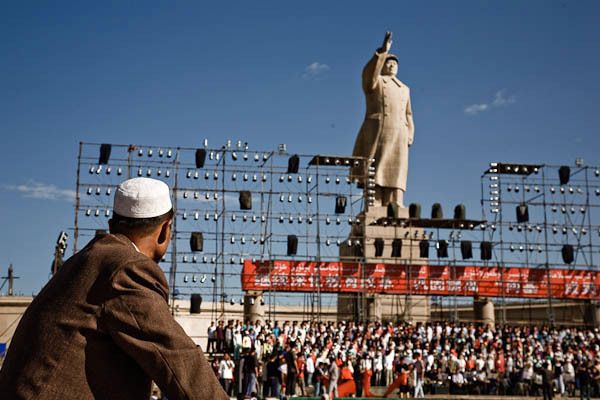The Nepali text version of this article was published on a Birenderanagar based regional daily Sajha Bisaunee
An article published recently on the Diplomat reported on the progress of the joint Kazakhstan – China projects signed between the Republic of Kazakhstan and the People’s Republic of China (PRC) recognized under “Intergovernmental Framework Agreement on strengthening cooperation in the field of Industrialization and Investment”. Signed in 2015 between the two neighboring governments, the agreement pledges to fulfill 56 industrial capacity development projects of Kazakhstan worth USD 27.6 billion in industrial sectors listed as metallurgy, oil and gas processing, chemical industry, mechanical engineering, power engineering, transport, production of building materials and agro-industrial complex.
The framework agreement comes as a flagship development of Silk Road Economic Belt (SREB) apart from Urumqi-Tehran railway project and China-Pakistan Economic Corridor (CPEC) that aspires to connect and create industrial and trade corridors between Central Asia, Middle-East Asia, and China. As part of the framework, China vows to export is excess industrial capacity in primary commodity manufacturing and processing industries to Kazakhstan while it looks forward to climb the global industrial value chain by becoming the exporter and standard-setter of advanced manufacturing technologies in high-speed railway transport, telecommunication, medicine, and energy across Asia and beyond. In the meantime, Kazakhstan is likely to witness advancement in its processing technologies in oil & gas sector in along with other industrial capacity so in order to be able to diversify its industrial and export portfolio in various industrial and refined petrochemical products. Until present since 1997, nascent oil & gas infrastructure of Kazakhstan has only been able to export low-grade oil in exchange of processed gasoline and motor oil from China.
Most importantly, apart from industrial connectivity, trade development, and strategic economic ambitions, the purpose of China to invest on the framework agreement with Kazakhstan also reveals its geostrategic interest of diversifying its oil supply from sea-route to in-land based route. Regarding which, the article reports the signing of design contract for a new China-Kazakhstan cross-border LPG pipeline in May 2020 as part of the latest progress of the framework agreement. Not to mention, 11 projects of the agreement that relates with oil & gas sector have either completed, in progress, or is pledged to begin in coming years.
Amid the revitalization of the silk road era trade and transit interaction between Central Asia and China, certain benefit from it may as well be imagined for the countries across the Himalayas.Specifically, in the context of Nepal, one can conceptualize the likely possibility for the Karnali region to be able to establish trade and transit connections with the Central Asia-derived economic and trade ambitions of China. This conceptualization derives from the spatial observation that the Hilsa region of upper-Karnali appears to be less than 2000 KM from Kasghar city of Xinjiang Province of China from Burang City of Tibet connected by the China National Highway 219. Meanwhile, the Kasghar and Urumqi city recognized to be the spout of SREB is expected to be multifacetedly connected with the Central Asian capital cities including through the railways and gas pipelines.
This spatial observation is in fact the western aspect of what is dubbed as Trans-Himalayan Multi-connectivity Network (THMCN) that strives to find alternative tract for trade & transit possibility through the Trans-Himalayan route with Nepal being at the center. Meanwhile, the historic ten-pact trade agreement signed between China and Nepal in 2016 during the last visit of Prime Minister KP Oli to Beijing has allowed Nepal to take a leap forward towards realizing the revitalization of its own Himalayan silk road with upper-Karnali region being at the crux of this development.
Specifically, the first point of agreement to allow Nepal to use China to conduct third-country trade and import critical resources, and the second point of the agreement to construct, manage, and maintain the Xiawara boundary river bridge in Hilsa bordering China is what brings Karnali a step closer to be able to regionally find avenues to trade with Central Asia. Having said that, it even improves the chances for Karnali to be able to find its development trajectory independently from the central government. Least to say, such conceptual arrangement can be the difference between Karnali province finding its space in the dawn of trade, transit, and economic revitalization of in-land Asia through SREB and helplessly depending upon the grant of the central government to sustain the livelihood of Karnali known to have historically suffered the incidence of poverty in Nepal.
Moreover, the likeliness of Nepal to also be able to diversify its oil-importing sources also through in-land route from Kazakhstan via Western China by taking advantage of the said energy infrastructure projects between Kazkhstan and China can establish upper-Karnali or specifically the Humla district as the northern dry custom and storage point for petroleum products. In fact, extended trade with Western China and Central Asia through upper-Karnali can even establish the Humla district as the landlocked trade city or strategic hub facilitated by trade-conducive industries as freight & warehousing, banking & insurance within it. In the meantime, the surge in number of tourists from in-land Asia would naturally follow given the natural beauty and socio-cultural destinations throughout the Karnali corridor. Given that, the contribution of such transit connectivity can be phenomenal for the economy of the Karnali.
While this Karnali-derived idea of THMCN to establish trade and transit linkage with in-land Asia might appear a far-fetched dream, it however should not be taken in a very light note. At least, the developments in Central and in-land Asia as part of the SREB efforts needs to be continuously watched while constantly deliberating the possible ways to integrate the Karnali region with economic momentum in the region to allow Karnali to find its alternative launchpad to economic growth. Suffice to say, the geostrategic significance of upper-Karnali to connect with West China and Central Asia should not be readily dismissed at present.





















